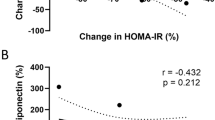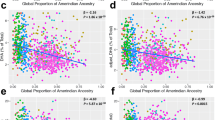Abstract
Objective:
Inflammation in adipose tissue may link obesity to insulin resistance and atherosclerosis. Arachidonate 5-lipoxygenase activating protein (ALOX5AP) gene is involved in the pathogenesis of atherosclerotic cardiovascular disease (CVD). We investigated ALOX5AP expression in adipose tissue, and association of gene polymorphisms with obesity and insulin resistance.
Design:
For gene expression analysis in adipose tissue, we studied 12 lean and 36 obese women, eight lean and 13 obese men, and nine women before and 2–4 years after gastric banding surgery. For genetic analysis, we studied 231 nonobese and 350 obese men.
Results:
The ALOX5AP protein, 5-lipoxygenase activating protein (FLAP), as well as 5-lipoxygenase (5LO) itself, were detected in adipocytes. The mRNA expression of ALOX5AP in subcutaneous adipose tissue was increased in obesity and normalized following weight reduction. High adipose tissue mRNA expression of ALOX5AP is associated with insulin resistance as measured by homeostasis model assessment (HOMAIR). ALOX5AP haplotypes that associate with CVD are not associated with obesity or insulin resistance.
Conclusion:
ALOX5AP is present in adipose tissue, where its expression is associated with body weight and HOMAIR, and may provide a link between adipose tissue, inflammation and insulin resistance. Investigated ALOX5AP haplotypes are not major primary risk factors for obesity and insulin resistance.
This is a preview of subscription content, access via your institution
Access options
Subscribe to this journal
Receive 12 print issues and online access
$259.00 per year
only $21.58 per issue
Buy this article
- Purchase on Springer Link
- Instant access to full article PDF
Prices may be subject to local taxes which are calculated during checkout


Similar content being viewed by others
References
Danesh J, Whincup P, Walker M, Lennon L, Thomson A, Appleby P et al. Low grade inflammation and coronary heart disease: prospective study and updated meta-analyses. BMJ 2000; 321: 199–204.
Libby P . Inflammation in atherosclerosis. Nature 2002; 420: 868–874.
Pradhan AD, Manson JE, Rifai N, Buring JE, Ridker PM . C-reactive protein, interleukin 6, and risk of developing type 2 diabetes mellitus. Jama 2001; 286: 327–334.
Barzilay JI, Abraham L, Heckbert SR, Cushman M, Kuller LH, Resnick HE et al. The relation of markers of inflammation to the development of glucose disorders in the elderly: the Cardiovascular Health Study. Diabetes 2001; 50: 2384–2389.
Weisberg SP, McCann D, Desai M, Rosenbaum M, Leibel RL, Ferrante Jr AW . Obesity is associated with macrophage accumulation in adipose tissue. J Clin Invest 2003; 112: 1796–1808.
Xu H, Barnes GT, Yang Q, Tan G, Yang D, Chou CJ et al. Chronic inflammation in fat plays a crucial role in the development of obesity-related insulin resistance. J Clin Invest 2003; 112: 1821–1830.
Arner P . The adipocyte in insulin resistance: key molecules and the impact of the thiazolidinediones. Trends Endocrinol Metab 2003; 14: 137–145.
Dixon RA, Diehl RE, Opas E, Rands E, Vickers PJ, Evans JF et al. Requirement of a 5-lipoxygenase-activating protein for leukotriene synthesis. Nature 1990; 343: 282–284.
Bocher V, Pineda-Torra I, Fruchart JC, Staels B . PPARs: transcription factors controlling lipid and lipoprotein metabolism. Ann NY Acad Sci 2002; 967: 7–18.
Mandard S, Muller M, Kersten S . Peroxisome proliferator-activated receptor alpha target genes. Cell Mol Life Sci 2004; 61: 393–416.
Huang L, Zhao A, Wong F, Ayala JM, Struthers M, Ujjainwalla F et al. Leukotriene B4 strongly increases monocyte chemoattractant Protein-1 in human monocytes. Arterioscler Thromb Vasc Biol 2004; 24: 1783–1788.
Bruun JM, Lihn AS, Pedersen SB, Richelsen B . MCP-1 release is higher in visceral than subcutaneous human adipose tissue. implication of macrophages resident in the adipose tissue. J Clin Endocrinol Metab 2005; 90: 2282–2289.
Christiansen T, Richelsen B, Bruun JM . Monocyte chemoattractant protein-1 is produced in isolated adipocytes, associated with adiposity and reduced after weight loss in morbid obese subjects. Int J Obes Relat Metab Disord 2005; 29: 146–150.
Sartipy P, Loskutoff DJ . Monocyte chemoattractant protein 1 in obesity and insulin resistance. Proc Natl Acad Sci USA 2003; 100: 7265–7270.
Silva AR, de Assis EF, Caiado LF, Marathe GK, Bozza MT, McIntyre TM et al. Monocyte chemoattractant protein-1 and 5-lipoxygenase products recruit leukocytes in response to platelet-activating factor-like lipids in oxidized low-density lipoprotein. J Immunol 2002; 168: 4112–4120.
Helgadottir A, Manolescu A, Thorleifsson G, Gretarsdottir S, Jonsdottir H, Thorsteinsdottir U et al. The gene encoding 5-lipoxygenase activating protein confers risk of myocardial infarction and stroke. Nat Genet 2004; 36: 233–239.
Peters-Golden M, Brock TG . 5-lipoxygenase and FLAP. Prostaglandins Leukot Essent Fatty Acids 2003; 69: 99–109.
Lofgren P, Hoffstedt J, Ryden M, Thorne A, Holm C, Wahrenberg H et al. Major gender differences in the lipolytic capacity of abdominal subcutaneous fat cells in obesity observed before and after long-term weight reduction. J Clin Endocrinol Metab 2002; 87: 764–771.
Eriksson P, Reynisdottir S, Lonnqvist F, Stemme V, Hamsten A, Arner P . Adipose tissue secretion of plasminogen activator inhibitor-1 in non-obese and obese individuals. Diabetologia 1998; 41: 65–71.
Hoffstedt J, Arvidsson E, Sjolin E, Wahlen K, Arner P . Adipose tissue adiponectin production and adiponectin serum concentration in human obesity and insulin resistance. J Clin Endocrinol Metab 2004; 89: 1391–1396.
Bonora E, Targher G, Alberiche M, Bonadonna RC, Saggiani F, Zenere MB et al. Homeostasis model assessment closely mirrors the glucose clamp technique in the assessment of insulin sensitivity: studies in subjects with various degrees of glucose tolerance and insulin sensitivity. Diabetes Care 2000; 23: 57–63.
Reynisdottir S, Wahrenberg H, Carlstrom K, Rossner S, Arner P . Catecholamine resistance in fat cells of women with upper-body obesity due to decreased expression of beta 2-adrenoceptors. Diabetologia 1994; 37: 428–435.
Curat CA, Miranville A, Sengenes C, Diehl M, Tonus C, Busse R et al. From blood monocytes to adipose tissue-resident macrophages: induction of diapedesis by human mature adipocytes. Diabetes 2004; 53: 1285–1292.
Arvidsson E, Blomqvist L, Ryden M . Depot-specific differences in perilipin mRNA but not protein expression in obesity. J Intern Med 2004; 255: 595–601.
Mandal AK, Skoch J, Bacskai BJ, Hyman BT, Christmas P, Miller D et al. The membrane organization of leukotriene synthesis. Proc Natl Acad Sci USA 2004; 101: 6587–6592.
Syvanen AC, Aalto-Setala K, Harju L, Kontula K, Soderlund H . A primer-guided nucleotide incorporation assay in the genotyping of apolipoprotein E. Genomics 1990; 8: 684–692.
Chen X, Levine L, Kwok PY . Fluorescence polarization in homogeneous nucleic acid analysis. Genome Res 1999; 9: 492–498.
Andersson P, Serhan CN, Petasis NA, Palmblad J . Interactions between lipoxin A4, the stable analogue 16-phenoxy-lipoxin A4 and leukotriene B4 in cytokine generation by human monocytes. Scand J Immunol 2004; 60: 249–256.
Acknowledgements
The excellent technical assistance of Kerstin Wåhlén, Katarina Hertel, and Britt-Marie Leijonhufvud is greatly acknowledged. This study was supported by grants from the Swedish Research Council, Swedish Heart and Lung Foundation, Novo Nordic foundation, Swedish Diabetes Association. King Gustaf and Queen Victoria Foundation, Diabetes Research and Wellness Foundation, EFSD, Karolinska Institutet, the K&A Wallenberg foundation via Wallenberg Consortium North (WCN), and the Swedish Society of Medicine.
Author information
Authors and Affiliations
Corresponding author
Rights and permissions
About this article
Cite this article
Kaaman, M., Rydén, M., Axelsson, T. et al. ALOX5AP expression, but not gene haplotypes, is associated with obesity and insulin resistance. Int J Obes 30, 447–452 (2006). https://doi.org/10.1038/sj.ijo.0803147
Received:
Revised:
Accepted:
Published:
Issue Date:
DOI: https://doi.org/10.1038/sj.ijo.0803147



